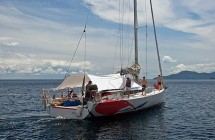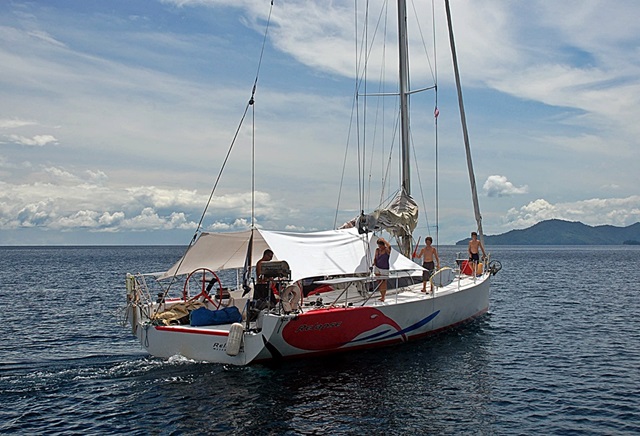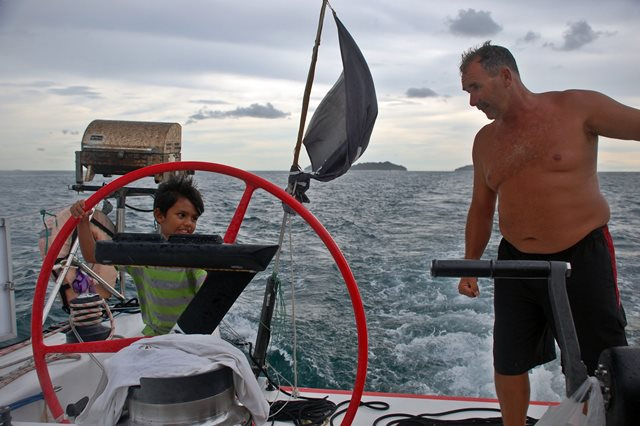
We have shared the story of Mark Edwards a couple of months ago. After all the comments and reactions of his story, he wants to address the readers and clarify the financial point of view.
Mark is truck driver, rigger, and boat builder from New Zealand. He’s a kiwi sailor with many miles of Pacific Ocean sailing, including a few Sydney Hobart races. We had heard about Mark and his family because they are another ‘kid boat’, described to us as the family on the racing boat. At first appearance Relapse is 50’ of pure racing machine, though oddly adorned with ratty awning, fishing poles, and a rusting (so called stainless!) BBQ grill, just like all the other cruising boats. Relapse, by traditional cruising convention, is born out of insanity with her 14’ wide transom, open for the world and Neptune to board any time they like.

Kids from Totem and Relapse were fast friends. The adults took much longer –say, 5 minutes. In true kiwi fashion Mark offered a beer to seal our friendship and we chatted away in their expansive cockpit. After awhile he asked, “aren’t you going to comment on how wet our cockpit must be? Everyone does,” he went on, “and someone will before you get off of the boat.”
Sure enough, old salty wanders by and says she must be fast, but so wet and unsafe with kiddies aboard. Mark’s wife Catherine rolls her eyes. Mark smiles at me and begins, patiently and respectfully. “This is my interpretation of a cruising boat,” he says. “I built this boat. We can easily sail 250 miles per day, as a family with kiddies; and we never ever have water boarding through the open transom because we move faster than waves.” The wide transom provides massive buoyancy. A traditional cruising boat by comparison has more weight and a narrower transom, less buoyancy; coupled with slower sailing speed, the chances of taking boarding seas are much greater on a traditional cruising boat.
A few more people join the conversation, trying to find a flaw in Mark’s approach; questions and answers flying about like birds in a squall. She can’t be strong enough, with so many stories about offshore racing boats breaking apart and keels falling off. That never happens on a cruising boat. Offshore racing boats are engineered and built with little safety margin to save weight. Relapse is engineered and built with big safety margins, just like your boat. As for the keel, it’s a torpedo shaped bulb at the end of a 9’ fin. It’s very efficient, like a racing boat, and very strong, which Mark adds they proved by accident after hitting a coral head at 7 knots. When they hauled the boat to inspect, they found only that the bulb was bent slightly and nothing else: no bulkhead movement, and not so much as a hairline fracture where the hull and keel meet –remarkable really.
During the course of the Borneo International Yacht Challenge, where we got to know Mark and Catherine, I watched Mark make his case several times. Skeptics departed more open to accepting Relapse into the cruising herd, if not in outright envy of many of her features. Two rudders offer better sailing efficiency and redundancy should one be damaged. A wide beam carried aft to the transom offers much open deck space and excellent form stability (hull shape that naturally resists rolling, much like comparing the rolliness of a popsicle stick to a pencil) and increased volume below for living and storage space. It has sailing characteristics that every sailor should envy: a helm so balanced that a six year can easily manage it, sailing a straight line without so much as a pinky on the wheel, and pointing to 35 degrees upwind –with speed. Not that cruisers go upwind much, but when people point out how inappropriate a boat like Relapse is for cruising they should consider how well a traditional cruising boat does if forced to sail upwind to escape a lee shore. Or what the pucker factor aboard is like when a stretch of ocean offers 4 day weather windows sandwiched between bad weather –and it’ll take you six days to Mark’s three. Performance matters.
I had asked Mark why he thinks so many cruisers and in particular North American sailors hold fast to a narrow view of what a cruising boat is. He answered in effect, that you (North Americans) all read about the Pardey’s approach to cruising and about how an Americas Cup boat breaks up in 10 knots of wind. The dichotomy is stark and cruising culture has matured with the idea that safety comes at the expense of speed.

Before we bought Totem I thought that transitioning from racing to cruising meant trading in running sneakers for steel toed boots. Circumnavigator Jim Jessie convinced me otherwise, saying “you want a boat tougher than you are, and one that can sail out of its own way.” Totem is no Relapse, but she has a balance of toughness and performance that serves us well. She just proved this again, while reaching along a shallow and barren stretch of the Borneo coastline at 8.5 to 9 knots in rough conditions, allowing us to reach our destination in daylight – important considering size and quantity logs floating about.
Every boat is a compromise, often selected through further compromises between money, location, and time. What matters most is that your boat makes you happy on more than first and last days of ownership. Mark’s interpretation also matters. He’s not alone in the message, but has gone well beyond what many open minded sailors think a cruising boat should be; and rightly so. Why can’t a cruising boat have the look and feel of performance and still be tougher than you are, as Jim Jessie says? It doesn’t have to mean a 9’ draft with a bulb keel, in the same way that a keel resembling a jersey barrier certainly doesn’t make the boat safer. If some old dog argued otherwise, then ask them how well they could sail off the lee shore or beat out bad weather. Tell them that there ought to be more puppies on the dock
